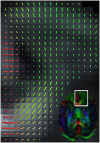Recent advancements in diffusion MRI for investigating cortical development after preterm birth-potential and pitfalls
- PMID: 25653607
- PMCID: PMC4301014
- DOI: 10.3389/fnhum.2014.01066
Recent advancements in diffusion MRI for investigating cortical development after preterm birth-potential and pitfalls
Abstract
Preterm infants are born during a critical period of brain maturation, in which even subtle events can result in substantial behavioral, motor and cognitive deficits, as well as psychiatric diseases. Recent evidence shows that the main source for these devastating disabilities is not necessarily white matter (WM) damage but could also be disruptions of cortical microstructure. Animal studies showed how moderate hypoxic-ischemic conditions did not result in significant neuronal loss in the developing brain, but did cause significantly impaired dendritic growth and synapse formation alongside a disturbed development of neuronal connectivity as measured using diffusion magnetic resonance imaging (dMRI). When using more advanced acquisition settings such as high-angular resolution diffusion imaging (HARDI), more advanced reconstruction methods can be applied to investigate the cortical microstructure with higher levels of detail. Recent advances in dMRI acquisition and analysis have great potential to contribute to a better understanding of neuronal connectivity impairment in preterm birth. We will review the current understanding of abnormal preterm cortical development, novel approaches in dMRI, and the pitfalls in scanning vulnerable preterm infants.
Keywords: DTI; cortical development; cortical development and plasticity; cortical imaging technique; diffusion MRI; diffusion magnetic resonance imaging; prematurity.
Figures


References
Publication types
LinkOut - more resources
Full Text Sources
Other Literature Sources

